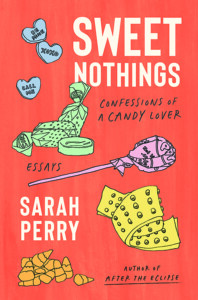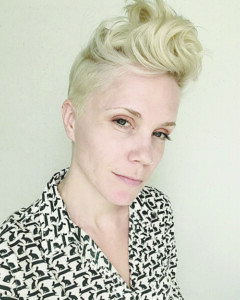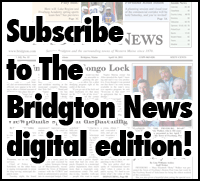Sweet Nothings — Author Sarah Perry confesses to her love of candy in second novel

By Wayne E. Rivet
Staff Writer
After writing her first novel, After the Eclipse, which pieced together the life and tragic death of her mother, Crystal, Sarah Perry found herself mentally exhausted.
She needed a break, but her drive to write refused to take time off. So, Sarah dabbled. She wrote a collection of essays about a topic she found simple, fun and uplifting. Although she initially didn’t expect to see the words turn into her second novel, Sweet Nothings: Confessions of a Candy Lover, is a “fun, sophisticated illustrated collection of essays that catalogs the simple — and not so simple — pleasures of the eclectic world of candy.”
The book is set for release next week, Feb. 4.
“Perry and candy have a magnetic relationship, inexorably drawn to each other... the author unwraps much more than a lifetime’s fixation on candy. While Perry’s accounts of candy consumption are sensual, almost tactile, and indescribably delicious, each chapter is also a pathway to deep recollection of the past, not all of it sugarcoated…Perry can tap into the communal candy memory with a fine comedic touch, calling forth many a Yes! Moment,” — Kirkus Reviews.

A taxonomy of sweetness, a rhapsody of artificial flavors, and a multi-faceted theory of pleasure, Sweet Nothings: Confessions of a Candy Lover is made up of 100 illustrated micro-essays organized by candy color, from the red of Pop Rocks to the purple Jelly Bonbon in the Whitman’s Sampler. Each entry is a meditation on taste and texture, a memory unlocked. Everyone’s favorites — and least favorites — are carefully considered, including Snickers and Trader Joe’s Peanut Butter Cups, as well as the beloved Good n’ Plenty and Werther’s Originals.
An expert guide and exquisite writer, Perry asks such pressing questions as: Twizzlers or Red Vines? Why are Mentos eaters so maniacally happy? She rejects the dreaded “What is your favorite candy?” question and counters: Under what circumstances? In what weather? In what mood? For candy is inextricably tied to the seasons of our lives. Sweet Nothings moves associatively, touching on pop culture, art, culinary history, philosophy, body image, and class-based food moralism. It challenges the very idea of “junk” food and posits taking pleasure seriously as a means of survival.
Perry’s pure love of candy weaves together elegiac glimpses of her 90s childhood — and the loss at its center — with stories of love and desire. Her previous work, After the Eclipse, cemented her as a critically acclaimed writer with accolades from NYT, Entertainment Weekly, W Magazine and more. Perry’s latest endeavor promises to be equally impactful, with its blend of nostalgic charm and intellectual rigor. Surprisingly smart and frequently funny, it’s perfect for anyone who loves a good story, appreciates fine writing, and, of course, has a sweet tooth.
Sarah Perry, formerly of Bridgton, is the author of the memoir After the Eclipse, which was named a New York Times Book Review Editors’ Choice, a Poets & Writers Notable Nonfiction Debut, and a Barnes & Noble Discover Great New Writers pick.
Perry is the recipient of the 2018 Betty Berzon Emerging Writer Award and was a nominee for the 2024 MFK Fisher Distinguished Writing Award from the James Beard Foundation.
She holds an MFA in Nonfiction from Columbia University, was the 2019 McGee Distinguished Professor of Creative Writing at Davidson College, and teaches in the graduate program in creative writing at Colorado State University.
Sarah’s mother, Crystal, was the victim of a brutal stabbing at her Sweden Road home in 1994. Age 12 at the time of the murder, Sarah fled the home after the attack, running in darkness to seek help. The case went unsolved for 13 years, but in 2007, Michael K. Hutchinson was convicted of Crystal’s murder and is now serving a life sentence.
The News posed the following questions to Sarah regarding her latest book:
BN: Where did the idea of basing a book on candy come from? It’s certainly a far departure from your first book.
Sarah P: After the Eclipse was a privilege to write and get out into the world, but it was also, as you might imagine, emotionally and psychologically draining. In the years after it came out, I was working on another memoir and some personal essays, but it felt like I was still bogged down in sadness and processing difficult things that had happen in my life.
Then in 2020, everything in the world was hard. I have a HUGE sweet tooth, and my partner, the writer Preston Witt, had been urging me to write about candy for a long time. So, I finally gave it a shot: I resolved to write about a different candy every day for 100 days straight. I just wanted to celebrate something I loved, and enjoy writing sentences again. Eventually, I “confessed” to my agent that I had 65,000 words of this weird little project, and she loved it!
BN: In the press release, it states, “She rejects the dreaded ‘What is your favorite candy?’ question and counters: Under what circumstances? In what weather? In what mood? For candy is inextricably tied to the seasons of our lives.” Can you elaborate?
Sarah P: So, the book partly grew of out my feeling confounded by this question, “What’s your favorite candy?” Because it really depends. Candy is this pleasurable and joyful thing, something you can use to brighten your mood or reminisce about the past, and I find that I want a different candy depending on what’s happening at the moment. If I’m feeling sad, I might go more toward chocolate, because it’s so rich and melty and soothing; if I’m on the beach in the sunshine, maybe I want gummy bears instead (here we have the temperature concern, too!). And, looking back, I’ll have eras where I prefer a certain candy over others, and then if I eat that candy later, it’ll take me back to that time. Taste is so closely tied to memory. Like, Swedish Fish are always the Magic Lantern for me!
BN: The release also states, “each chapter is also a pathway to deep recollection of the past, not all of it sugarcoated...” Can you give a few examples and explain?
Sarah P: So, even though I wanted to move away from some of the sadness of After the Eclipse, Mom is still pretty present in this book. In one piece where I write about Strawberry Rip Rolls, I’m recounting the first time I ate them, and how the smell of them was just like the strawberry shampoo that Mom would use when she gave me a bath when I was very little. My essay about cotton candy is about this kind of golden memory of being with her at the Fryeburg Fair. So, there are pieces where there’s this gentler feeling of grief and loss.
There are also some pieces that dig into history and war (as candy is really connected to war!) and some of the ills of society — I wanted to take my own personal memories but expand the lens a bit, so that the essays considered some higher stakes ideas. There are also some pieces—only a few—that deal with, let’s say, wild adventures I’ve had. Which is to say that although the book is about candy, and it’s illustrated by my dear friend Forsyth Harmon, it’s not for kids!
BN: What is the true magic of candy?
Sarah P: Candy is really cool because it’s usually not tied to any particular rituals of eating — generally, people don’t eat candy in the morning (although the Dutch sometimes eat Hagelslag, which is bread-and-butter topped with chocolate sprinkles, for breakfast), but otherwise you can kind of eat candy whenever you want. You can eat it on the go (I especially love candy on planes, when you’re otherwise pretty uncomfortable) or you can carry it around in your pocket for candy emergencies.
It’s also true that people have A LOT of memories about candy, especially from childhood. It’s this thing we first experience before we’ve experienced much of the world at all, when everything that happens to us is new and has such an impact. The most fun part of writing this book has been that people will tell me these really intimate, happy memories about candy!
BN: What was your biggest challenge in writing this book?
Sarah P: I wrote the book in 104 sections, and then had to cut it down to 100 and sequence them. I want the book to read well from beginning to end, but also be something fun where you can just pick it up and randomly read one or two pieces. So, I had to figure out how to get the pieces to work on their own and together. I did this with colored coded notecards, in a few rounds. There’s a method to how each color-coded section is sequenced, both on the level of the book and within the sections. It was a lot of trial and error, both systematic work and instinct.
I also had drafted the essays in 100 days and then worked to add research and make them a bit more weighty. I learned so many interesting things and went down so many research rabbit holes that it was really hard for me to stop writing and decide the book was done. My agent and editor had to help with that!
BN: What are you most pleased with?
Sarah P: I’m so encouraged by the fact that I just wrote about something I love, with no intent of making those words into a book, just to please myself and to recover creatively and personally, and then the publishing market responded really positively and now the book is out in the world. It makes me really hopeful, and reinforces a lot of what I tell my writing students — you have to go toward your instincts.
BN: Obviously here, people know about your tragic story. What/who has influenced you and helped you push forward and become a successful writer?
Sarah P: As a little kid, I loved writing stories, and I got a lot of encouragement from my teachers at BES (Bridgton Elementary School), and from Mom. I remember my teacher in first grade, Ms. Flickinger (who I don’t think is around anymore? Not sure) would type up my stories and I would illustrate them, and she would bind them in cardboard with these colored-tape bindings. I still have those books and figured out, in the process of researching After the Eclipse, that the cardboard was from discarded shoe boxes from the shoe shop where Mom worked (Pleasant Mountain Moccasin). How cool is that?
And I distinctly remember Mrs. Anderson, in second grade, advising me not to change my name when I got married, because she wanted to be able to find my books someday.
And of course, Liz Shane, who was my last teacher in Bridgton and interviewed me for the launch of After the Eclipse in town, was supportive. Now I’m reminiscing too much. But I guess it’s been important that even though I had a lot of disruption in my life, I was incredibly lucky to know, from a very young age, what I wanted to do, and to have people who believed in that.
Also, Stephen King being nearby gave me the sense that books were written by real, live people, and maybe I could be one of those people.
I’ve also now invested in the career and personal moves necessary to support a writing and teaching career. A writer has to have a lot of other skills than just the writing to be successful!
BN: How does Sweet Nothings show another side of you and your writing ability?
Sarah P: It turns out I can be funny on the page, which was the biggest surprise! At first, I wasn’t showing the “candies” — as I called them, because I didn’t even know they would be essays — to anyone. They were just for me. But at some point, I started reading them aloud to my partner, Preston, and he would laugh! Oh, that’s the best feeling. I, of course, was not used to making people laugh with my writing. And that’s part of what made me start to value this project — in these really difficult times, maybe I could give people a little joy. I had never written in this short format before, which was really fun.
BN: Where can people purchase the book?
Sarah P: At Bridgton Books! Or online. There’s this wonderful alternative to Amazon called Bookshop.org, where you can order books online, but you can also designate an independent bookstore to get part of the proceeds. So, if you can’t make it into the store for whatever reason, you can do that. But any independent store will either have the book, or be able to order it for you. Independent bookstores are really important to publishers and writers and to making sure that we can continue to provide interesting, varied stories.
BN: What comes next?
Sarah P: For the next couple months, I’ll be pretty busy getting Sweet Nothings out into the world, with 10 or so tour stops. After that, I’m going to turn back to some of the heavier essays that I had been working on before I dove into the world of candy. I feel more ready to do that work now. A lot of those pieces are about true crime and how complicated it is, ethically, and how my own life has intersected with that. But I’m also working on an essay about how awesome maraschino cherries are. 🙂

